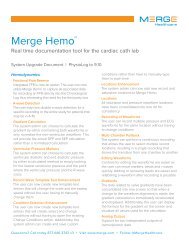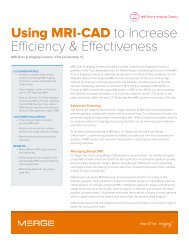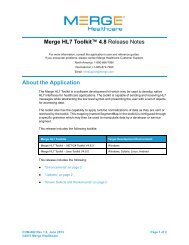Message Database Manual V4.8.0 - Merge Healthcare
Message Database Manual V4.8.0 - Merge Healthcare
Message Database Manual V4.8.0 - Merge Healthcare
You also want an ePaper? Increase the reach of your titles
YUMPU automatically turns print PDFs into web optimized ePapers that Google loves.
e DICOM Toolkit<strong>Message</strong> <strong>Database</strong> <strong>Manual</strong><strong>Merge</strong> DICOM ToolkitC/C++ <strong>Database</strong> <strong>Manual</strong>v.4.8.0<strong>Merge</strong> <strong>Healthcare</strong>900 Walnut Ridge DriveHartland WI 53029USA877.44.MERGE
Copyright 2013 <strong>Merge</strong> <strong>Healthcare</strong> IncorporatedUnauthorized use, reproduction, or disclosure is prohibited.This document has been prepared by <strong>Merge</strong> <strong>Healthcare</strong> Incorporated, for itscustomers. The content of this document is confidential. It may be reproducedonly with written permission from <strong>Merge</strong> <strong>Healthcare</strong>. Specifications containedherein are subject to change, and these changes will be reported in subsequentrevisions or editions.<strong>Merge</strong> <strong>Healthcare</strong>® is a registered trademark of <strong>Merge</strong> <strong>Healthcare</strong> Incorporated.<strong>Merge</strong> DICOM Toolkit is a trademark of <strong>Merge</strong> <strong>Healthcare</strong>. The names of otherproducts mentioned in this document may be the trademarks or registeredtrademarks of their respective companies.For assistance, please contact <strong>Merge</strong> <strong>Healthcare</strong> Customer Support:• In North America, call toll free 1-800-668-7990, then select option 2• International, call <strong>Merge</strong> <strong>Healthcare</strong> (in Canada) +1-905-672-7990, then selectoption 2Email mdtsupport@merge.comPart Date Revision DescriptionCOM-883 June 2013 1.0 Updated bi-annually
<strong>Merge</strong> DICOM Toolkit<strong>Database</strong> <strong>Manual</strong>ContentsOVERVIEW ............................................................................................................ 1<strong>Message</strong> Dictionary Components ....................................................................... 2Conventions ........................................................................................................ 4DICTIONARY AND MESSAGE PROFILES ........................................................... 5Using mc3dcomb ................................................................................................ 6Using mc3icomb ................................................................................................. 7Format of mc3icomb’s configuration file ......................................................... 7Final overview of the process ....................................................................... 10GENERATING THE BINARY DATABASE ........................................................... 10Dictionary File Generation (mc3dict) ................................................................ 10<strong>Message</strong> Info File Generation (mc3info) .......................................................... 11ACCESSING PRIVATE ATTRIBUTES ................................................................ 12APPENDIX: DICTIONARY PROFILE SPECIFICATIONS ................................... 14Data File Descriptions ...................................................................................... 14Private Attribute Specification ........................................................................... 15Standard Attribute Specification ....................................................................... 16Private Attribute Specification ........................................................................... 18Example message info profile entry ................................................................. 18Extending the <strong>Message</strong> Info Profile .................................................................. 19iii
<strong>Merge</strong> DICOM Toolkit<strong>Database</strong> <strong>Manual</strong>OverviewThis database manual is targeted toward advanced developers of DICOMapplications using the <strong>Merge</strong> DICOM Toolkit that wish to:• Supplement the standard <strong>Merge</strong> DICOM message dictionary with privateextensions; and• Verify these private extensions through the message validation functionalityprovided by <strong>Merge</strong> DICOM Toolkit.<strong>Merge</strong> DICOM Toolkit supports the addition of private attributes at runtimethrough the use of the MC_Add_Private_Block(), andMC_Add_Private_Attribute() calls. This method is sufficient for mosttoolkit users where private attributes are encoded or accessed in a limitedmanner.For more advanced user’s (e.g. OEM customers) that maintain large groups ofprivate attributes across product lines, it is desirable to maintain these privateattributes in the <strong>Merge</strong> DICOM Toolkit Dictionary Files. Advantages of thisinclude:• Ability to maintain Private Dictionary extensions on-site, under appropriatesource-code control.• Ability to create product-specific message dictionaries.• Avoid the overhead of MC_Add_Private_...() calls before using privateattributes.• More ‘built-in’ knowledge about your own private attributes that are streamedin from DICOM messages over the network or from media.• Ability to validate your message objects against private extensions using theexisting MC_Validate_<strong>Message</strong>( ) call.Impacts on DICOMConformanceWhen adding Private Attributes to a standard DICOM message object (SOPClass) you are creating a Standard Extended, Specialized, or Private SOP Class,depending on the rules you follow. Part 2 of the Standard details these rules andhow each of these types of SOP classes effect conformance. Part 2 alsoexplains how to document these extensions within your DICOM ConformanceStatement. Be sure to read and understand Part 2 of DICOM before addingPrivate Attributes to DICOM messages.If the terminology being used here is confusing you need to read and understandthe other <strong>Merge</strong> DICOM Toolkit User <strong>Manual</strong>, and refer to the DICOM Standarditself, before continuing on with this manual. See the Documentation Roadmapsection below.1
<strong>Merge</strong> DICOM Toolkit<strong>Database</strong> <strong>Manual</strong><strong>Message</strong> Dictionary ComponentsWhen the <strong>Merge</strong> DICOM Toolkit validates a message through theMC_Validate_<strong>Message</strong>( ) call it accesses several binary dictionary files.These binary files are accessed during runtime via the file system. One of thesefiles, the DICOM Data Dictionary file, can also be kept in memory or staticallylinked into your application as an object module. See Figure 1.other sample applicationsSample Media AppSample Q/R AppSample Store AppASCII filesor linkedintoexecutableConfig Files:MERGE.INIMERGECOM.PROMERGECOM.APPMERGECOM.SRVDICOM Applicationlibrary header files<strong>Merge</strong>COM-3 AdvancedLibraryTCP/IPSocketsLibraryFile SystemDev. Driver<strong>Merge</strong>’s<strong>Message</strong> Info<strong>Database</strong> andDataDictionarybinary filesor linkedintoexecutableDICOM NetworkInterchangeable Media DeviceDICOM <strong>Database</strong>Maintenance ToolsKey:<strong>Merge</strong>ComponentsYourComponentsFigure 1: <strong>Merge</strong> DICOM Toolkit with <strong>Merge</strong> <strong>Healthcare</strong> Components Highlighted2
<strong>Merge</strong> DICOM Toolkit<strong>Database</strong> <strong>Manual</strong>For most applications, accessing the binary files is preferred because thisrequires less static memory and is easier to reconfigure (does not requirerebuilding executables). But, in embedded systems, where a file system is notavailable, statically linking in the Data Dictionary file allows attribute level (but notmessage level) validation, without requiring a file system.The <strong>Merge</strong> DICOM Toolkit configuration files can also be statically linked into toyour executable. Your application specifies how it wishes to access the dictionaryand configuration files using the MC_Library_Initialization( ) call. Seethe Reference <strong>Manual</strong> for further details.<strong>Merge</strong> may add the ability to statically link in message info files in the future, butat present the memory cost associated with this approach makes its appeallimited. It is most often the case, at least in embedded environments, thatdevelopment and test are done with a file system (allowing for message info files)and message-level validation is not done in the final production environment.Normally, the library uses the binary files and object files shipped with the toolkit.It is also possible for advanced developers to extend or specify their own privatedata dictionary and message info files. This document outlines the structure ofthe toolkit dictionary and message info files and describes the use of utilitiesneeded to generate new binary dictionary files.The <strong>Merge</strong> DICOM Toolkit documentation is structured as pictured in Figure 2.Read Me FIRST!The User’s <strong>Manual</strong> is the foundation for all other documentation because itexplains the concepts of DICOM and the DICOM Toolkit. Before plunging intothe Reference <strong>Manual</strong> or Sample Application Guides, you should be comfortablewith the material in the User <strong>Manual</strong>.The Reference <strong>Manual</strong> is where you go for detailed information on the DICOMToolkit. This includes the Application Programming Interface (API), toolkitconfiguration, the runtime object database, and status logging. The Reference<strong>Manual</strong> also includes a DICOM conformance statement for the toolkit.The DICOM <strong>Database</strong> <strong>Manual</strong> is an optional extension that describes theorganization of the <strong>Merge</strong> DICOM <strong>Database</strong> and how to use it to extend standardservices and define your own private services. Tools are supplied for convertingthe contents of the database into the binary runtime object database.SampleApplicationsThe Sample Application Guides describe approaches to developing specificclasses of DICOM applications (Image Transfer, Query/Retrieve, Print, HIS/RIS,Storage Media, etc.). They highlight pertinent information from Parts 3 or 4 of theDICOM Standard in a more readable way and in the context of the DICOMToolkit. The Application Guides also detail the DICOM messages that can bepassed between applications on the network. Also, a sample application isdescribed and the application supplied in source form for your platform.Platform-specific information required to use the DICOM Toolkit on your targetplatform are specified in Platform Notes. This includes supported compilers,compiler options, link options, configuration, and run-time related issues.3
<strong>Merge</strong> DICOM Toolkit<strong>Database</strong> <strong>Manual</strong>User’s<strong>Manual</strong>SampleApplicationGuidesReference<strong>Manual</strong>OPTIONALDICOM<strong>Message</strong><strong>Database</strong><strong>Manual</strong>Solaris Irix MS-etc.DOSPlatformNotesFigure 2: <strong>Merge</strong> DICOM Toolkit Documentation RoadmapConventionsThis manual follows a few formatting conventions.Terms that are being defined are presented in boldface.Sample Margin NoteMargin notes (in the left margin) are used to highlight important points or sectionsof the document.Sample commands appear in bold courier font, while sample output, sourcecode, and function calls appear in standard courier font.Hexadecimal numbers are written with a trailing H. For example 16 decimal isequivalent to 10H hexadecimal.4
<strong>Merge</strong> DICOM Toolkit<strong>Database</strong> <strong>Manual</strong>Dictionary and <strong>Message</strong> ProfilesThe operation of the <strong>Merge</strong> DICOM Toolkit and how it references binarydictionary and message info files or objects to perform runtime messagevalidation is detailed in Figure 1.Creating theDictionary FileThe binary data dictionary file is named mrgcom3.dct and contains a binarycoded representation of the DICOM data dictionary (as specified in Part 6 of theDICOM Standard). This includes all the standard attributes, their tags, names,value multiplicities (VM’s), and value representations (VR’s). A utility calledmc3dict is used to create this binary dictionary file on a specific platform froman ASCII input file (usually named diction.pfl). The ASCII input profile isplatform independent and developers can modify diction.pfl or create theirown dictionary profile and run them through mc3dict to generate a customizedmrgcom3.dct.Creating the<strong>Message</strong> Info FilesThe binary message info file has the name mrgcom3.msg and contains a binarycoded representation of DICOM Service Object Pairs (SOP’s. These SOP’sspecify the attributes (contained in the data dictionary) that make up a messageor item, their value type (VT), and any enumerated values or defined terms.Items that are used in attributes of VR Sequence of Item (SQ) are also specifiedin message info file. A utility called mc3info is used to create this binarymessage info file on a specific platform from a single ASCII input file (usuallynamed info.pfl).Figure 3 represents this conversion process for both the data dictionary andmessage profiles.ASCII Text FilesConversion Executables<strong>Message</strong> Dictionary Binary Filesdiction.pflmc3dictmrgcom3.dctplatformindependentplatformspecificinfo.pflmc3infomrgcom3.msgFigure 3: ASCII to Binary <strong>Message</strong> Dictionary Conversion Process<strong>Merge</strong> DICOM Toolkit also supports a gendict utility program that converts thebinary dictionary file into a source code module that can be compiled and linkedinto your application. Documentation of this conversion process can be found inthe Toolkit Reference <strong>Manual</strong>.The remainder of this document describes two utility programs mc3dcomb andmc3icomb. These two utility programs, along with the existing mergecom.srv,diction.pfl and info.pfl files are used to perform custom modifications tothe dictionary and message databases.5
<strong>Merge</strong> DICOM Toolkit<strong>Database</strong> <strong>Manual</strong>It is important to understand the layout of the “*.pfl” files before attempting touse the two combine utilities. This document also provides an appendix whichdescribes the manual process of extending the database by directly manipulatingthe mergecom.srv, info.pfl, and diction.pfl files.While <strong>Merge</strong> recommends that the combine utilities be used to perform dictionarychanges rather than manually changing the mergecom.srv, info.pfl, anddiction.pfl, it may be helpful to understand the layout of these files and howthe toolkit makes use of them.Figure 4: Input files and output files for the dictionary utility programs.Using mc3dcombThe “mc3dcomb” utility is used to merge the contents of two diction.pfl filestogether. One of the two files could be the included diction.pfl file that shipswith the toolkit while the other could contain all of the enhancements needed for aspecific application of the toolkit. This utility could also be used multiple times tocombine many different change files into a single file that would then be mergedwith the existing diction.pfl file.It is stipulated that the input files used by mc3dcomb be formatted just likediction.pfl. Given that, both files then need to be sorted in ascendingattribute order. That is, the order in each particular file must be ascending, butthere doesn’t need to be any correlation in order between the two files.The appendix should be consulted in order to see the format of diction.pflfiles.6
<strong>Merge</strong> DICOM Toolkit<strong>Database</strong> <strong>Manual</strong>The usage for mc3dcomb is the following:mc3dcomb Using mc3icombThe mc3icomb utility functions differently than does mc3dcomb in that it must domore processing on input files. mc3icomb must read in its configuration file(which contains the changes that a user wishes to make), read in the existingmergecom.srv, and read in the existing info.pfl. It must then merge all ofthis data into the proper format for the two files which it will output.As with mc3dcomb, mc3icomb can be used on multiple files, multiple times. Thisenables the user to use the output of one pass or run of mc3icomb as the inputfor another pass of mc3icomb.mc3icomb uses the following types of files for input:mergecom.srvinfo.pflconfigThe mergecom.srv file can be the mergecom.srv file that was shipped withthe toolkit. It can be any file that is formatted and contains information for amergecom.srv file.The info.pfl file can be the info.pfl file that was shipped with the toolkit. Itcan be any file that is formatted and contains information for an info.pfl file.The config file is a file which contains information that the user wishes to add toa set of existing info.pfl and mergecom.srv files. The format of the configfile is specific to this type of file and will be detailed later.mc3icomb creates the following output files:mergecom.srvinfo.pflThe two output files contain all of the changes specified within the config (input)file.Format of mc3icomb’s configuration fileAn example mc3icomb configuration file is shipped with the toolkit. It is alsoreproduced in its entirety, here. Each section’s functionality will be discussedafter it is enumerated:## This is an example of the configuration file that is used# by mc3icomb to modify a mergecom.srv and info.pfl file.# This file contains three sections. Each section must be# formatted properly in order for mc3icomb to parse it# correctly.## The following are examples of how each section should be# constructed.7
<strong>Merge</strong> DICOM Toolkit<strong>Database</strong> <strong>Manual</strong>The above block is nothing more than a comment block that describes thepurpose of the file. As can be seen by this example, comments are lines thatstart with the “#” character.# Section one contains any additions to standard (pre-# existing) messages or items.# This is where private attributes are usually added to# existing services.# This section can be blank if you aren't using it, but the # linecontaining the EXISTING keyword must remain as is.[ EXISTING_SERVICE_SECTION ][ BASIC_COLOR_IMAGE_BOX, N_SET_RSP ]0009,ACME Imaging Group,2A@PN@3@@;0009,ACME Imaging Group,2B@DT@3@@;As is mentioned in the comment block for this section, this is section one. Thestart of this section is denoted by the “EXISTING_SERVICE_SECTION” keyword.This keyword must exist in the file and must be formatted exactly as it looks in theabove example. It must be enclosed in square brackets, have a space betweenthe bracket and the keyword, and be separated from the section’s actualmodifications by a blank line. All keywords contained within this file must beformatted in this manner.The actual modifications are following the keyword delimiter and the blank line.The modifications are formatted in the following manner:[ Existing service, existing command ]Private Group,Creator Code,Element,@VR@VT@@;For more information regarding the format of the individual modification lines,please see the appendix. The appendix describes the format of these lines in thesection that describes adding private attributes to a message object (SOP).Section two begins after the section one modifications are placed in the configfile. The file contains a comment block describing the second section of the file.The comment block is followed by another delimiter. The delimiter is“PRIVATE_SERVICE_SECTION”.# Section two contains any private services which are going# to be created.# As with section one, this section can remain empty but the# PRIVATE_SERVICE_SECTION keyword must also remain exactly# as listed below.[ PRIVATE_SERVICE_SECTION ][ BASIC_DUMMY_MANAGEMENT, MESSAGE ]UID = 1.2.3.4.5.6DESCRIPTION= Basic dummy managementTYPE= BASE[ BASIC_DUMMY_MANAGEMENT, N_SET_RQ ]2030,0010@US@1@@;2030,0020@LO@3@@;[ BASIC_DUMMY_MANAGEMENT, N_SET_RSP ]2030,0010@US@1@@;2030,0020@LO@1@@;8
<strong>Merge</strong> DICOM Toolkit<strong>Database</strong> <strong>Manual</strong>Each newly added service is formatted like the example above. Each service isdelimited from the others by having its name contained within a delimiter. In theexample above, this name is “BASIC_DUMMY_MANAGEMENT”. As you cansee this service name corresponds to the definitions for each of this service’scommands, below.The service itself must have its UID, Description, and Type defined. This isdefined in the heading section.Following the service’s definition, the message’s command and the tags thatmake up the command are entered. It is important to note that the tags that eachcommand contains can be either private or standard. It is important to note thatthe lines that specify these are also defined in the appendix. The example aboveonly shows standard attributes.Once the new private services and commands are created, the configuration fileincludes a description for section three. There is also a delimiter that denotes thestart of section three: “PRIVATE_ITEM_SECTION”. As with other delimiters, itmust be followed by a blank line and properly formatted.# Section three contains any private items which are to be# created.# This section holds the complete definition of any private# items.# As with the other sections, this can remain empty but the# PRIVATE_ITM keyword line must remain exactly as listed# below.[ PRIVATE_ITEM_SECTION ]As shown in the comment above, section three contains the additions for privateitems. Each private item starts with the definition of the private item’s name, andis followed by the item’s tag contents.[ DUMMY_ITEM, ITEM ]0008,1150@UI@1@@;0008,1155@UI@1@@;As with other sections, section four starts with a delimiter:“EXISTING_ITEM_SECTION”. This delimiter denotes the start of additions toexisting items.# Section four contains modifications to any existing# standard items# which are to be added to. As with the other sections,# this one can also# remain empty but the STANDARD ITM keyword must remain# exactly as listed# below.[ EXISTING_ITEM_SECTION ]Section four definitions match the format of section three. In this case, the item’sname must already exist in the input database. If the item does not exist, an erroris logged.[ PREFORMATTED_COLOR_IMAGE, ITEM ]0008,2222@UI@1@@;0008,3333@UI@1@@;Note that the tags listed in this definition are added to an existing item’s definition.These can also be either private or existing.9
<strong>Merge</strong> DICOM Toolkit<strong>Database</strong> <strong>Manual</strong>Once both mc3icomb and mc3dcomb have been used to generate newconfiguration files, the user can continue with the generation of the binarydatabase files. This is discussed in the next section, and is no different had theuser modified the configuration files by hand.The usage for mc3icomb is as follows:mc3icomb Final overview of the processAs can be seen by the above descriptions, modifying the data dictionary for the<strong>Merge</strong> DICOM Toolkit can be accomplished by doing the following:1. Generate the configuration files for use with mc3icomb and mc3dcomb.These files contain the actual additions/changes to the database.2. Generate the final set of database files that you wish to use with thetoolkit. This involves using mc3icomb and mc3dcomb with yourconfiguration files and the original ASCII database files shipped with thetoolkit.3. Use mc3dict and mc3info to generate a new set of binary dictionaryfiles used by the toolkit.Generating the Binary <strong>Database</strong>Once the dictionary and message info profiles are in the correct format, they canbe translated to a binary format using the mc3dict and mc3info executables,respectively.Dictionary File Generation (mc3dict)Creating the binary dictionary file is a matter of running the mc3dict applicationspecifying a single parameter which is the dictionary profile. In the usual casewhere the dictionary profile is named diction.pfl the output of mc3dict lookslike the following:mc3dict - Generate <strong>Merge</strong> DICOM Binary Dictionary FileVersion 2.33(c) 2011 <strong>Merge</strong> <strong>Healthcare</strong>. All rights reserved.Number of Data Elements processed:100...200...300...400...500...600...700...800...804...DONE.This output shows the normal processing of a dictionary profile containing 804entries. mc3dict also has limited error detection. If it finds an input line with aninvalid format, it will alert the operator as follows:mc3dict - Generate <strong>Merge</strong> DICOM Binary Dictionary FileVersion 2.33(c) 2011 <strong>Merge</strong> <strong>Healthcare</strong>. All rights reserved.Number of Data Elements processed:ERROR: Invalid Input File format in line number 17.10
<strong>Merge</strong> DICOM Toolkit<strong>Database</strong> <strong>Manual</strong>The output file created is always the binary dictionary file mrgcom3.dct. For thebinary dictionary to be accessed properly at runtime, the mergecom.proconfiguration file for the toolkit must point to the location of theDICTIONARY_FILE in the [MESSAGE_PARMS] section. See the discussion oftoolkit configuration in the User’s <strong>Manual</strong> for further details.<strong>Message</strong> Info File Generation (mc3info)Creating the binary message info files involves running the mc3info applicationspecifying a single parameter which is the message info profile. In the usual casewhere the message info profile is named info.pfl the output of mc3info lookslike the following:mc3info - Generate <strong>Merge</strong> DICOM Binary <strong>Message</strong> Object FilesVersion 3.50(c) 2011 <strong>Merge</strong> <strong>Healthcare</strong>. All rights reserved.Generating info files for:Service #0001, Command = N_SET_RQ...Service #0001, Command = N_SET_RSP...Service #0002, Command = N_SET_RQ...Service #0002, Command = N_SET_RSP...Service #0003, Command = N_CREATE_RQ...Service #0003, Command = N_CREATE_RSP...Service #0003, Command = N_SET_RQ...Service #0003, Command = N_SET_RSP...Service #0003, Command = N_DELETE_RQ...Service #0003, Command = N_DELETE_RSP...Service #0003, Command = N_ACTION_RQ...Service #0003, Command = N_ACTION_RSP...Service #0004, Command = N_CREATE_RQ...Service #0004, Command = N_CREATE_RSP...Service #0004, Command = N_SET_RQ...Service #0004, Command = N_SET_RSP...Service #0004, Command = N_DELETE_RQ...Service #0004, Command = N_DELETE_RSP...Service #0004, Command = N_ACTION_RQ...Service #0004, Command = N_ACTION_RSP...Service #0005, Command = N_SET_RQ...Service #0005, Command = N_SET_RSP......Service #0041, Command = C_MOVE_RQ...Service #0041, Command = C_MOVE_RSP...Service #0041, Command = C_CANCEL_RQ...Service #0042, Command = N_CREATE_RQ...Service #0042, Command = N_CREATE_RSP...Service #0042, Command = N_SET_RQ...Service #0042, Command = N_SET_RSP...Service #0042, Command = N_DELETE_RQ...Service #0042, Command = N_DELETE_RSP...Item #0001...Item #0002...Item #0003...Item #0004...Item #0005......11
<strong>Merge</strong> DICOM Toolkit<strong>Database</strong> <strong>Manual</strong>DONE.Item #0080...Item #0081...Item #0082...Item #0083...Item #0084...Item #0085...Item #0086...Item #0087...Item #0088...Item #0089...This output shows the normal processing of the message info profile containingsome 160 messages over 42 services, and an additional 89 items. mc3infoalso has limited error detection. If it finds an input line with an invalid format, itwill alert the operator as follows:mc3info - Generate <strong>Merge</strong> DICOM Binary <strong>Message</strong> Object FilesVersion 3.50(c) 2011 <strong>Merge</strong> <strong>Healthcare</strong>. All rights reserved.Generating info files for:Service #0001, Command = N_SET_RQ...Service #0001, Command = N_SET_RSP...Service #0002, Command = N_SET_RQ...Service #0002, Command = N_SET_RSP...Service #0003, Command = N_CREATE_RQ...Service #0003, Command = N_CREATE_RSP...Service #0003, Command = N_SET_RQ...Service #0003, Command = N_SET_RSP...Service #0003, Command = N_DELETE_RQ...Service #0003, Command = N_DELETE_RSP...Service #0003, Command = N_ACTION_RQ...Service #0003, Command = N_ACTION_RSP...Service #0004, Command = N_CREATE_RQ...Service #0004, Command = N_CREATE_RSP...Service #0004, Command = N_SET_RQ...Service #0004, Command = N_SET_RSP...Service #0004, Command = N_DELETE_RQ...Service #0004, Command = N_DELETE_RSP...Service #0004, Command = N_ACTION_RQ...Service #0004, Command = N_ACTION_RSP...Service #0005, Command = N_SET_RQ...Service #0005, Command = N_SET_RSP...Service #0006, Command = N_GET_RQ...Service #0006, Command = N_GET_RSP...ERROR: Invalid Input File format in line number 183.The output file created is the binary message info files mrgcom3.msg.For the binary info file to be accessed properly at runtime, the mergecom.proconfiguration file for the toolkit must point to the location of the MSG_INFO_FILEin the [MESSAGE_PARMS] section. See the discussion of toolkit configuration inthe User’s <strong>Manual</strong> for further details.Benefits for theImplementor!Accessing Private AttributesOnce private attributes have been added to the binary dictionary file, three thingsoccur.• The same private attributes can be referenced in the message info file.12
<strong>Merge</strong> DICOM Toolkit<strong>Database</strong> <strong>Manual</strong>• Private attributes in the binary dictionary file, but not part of a messageobject, can be added to a message object using theMC_Add_Private_Attribute( ) call. No,MC_Add_Private_Block( )call is necessary for private attributes that have been added to the dictionaryfile. This is consistent with how MC_Add_Standard_Attribute( )already works.• When messages are received over the network, or read in from media, if theprivate attributes contained in that message are defined in your dictionarythey will be added to the message with a known VR and VM. They will alsoproperly appear in the output of MC_List_<strong>Message</strong>( ).Once private attributes have been added to a section of the message info file,three things occur.• Private attribute can be assigned values using the MC_Set_pValue_...( )functions. No MC_Add_Private_Block( ) orMC_Add_Private_Attribute( ) calls are necessary for a privateattributes that have been added to binary message info file.• When messages are received over the network, or read in from media, if theprivate attributes contained in that message are defined in yourcorresponding message info file they will be added to the message with aknown VT, and Defined Terms or Enumerated Values (if specified). They willalso properly appear in the output of MC_List_<strong>Message</strong>( ).• When MC_Validate_<strong>Message</strong>( ) is called, the private attributes will alsobe validated against the specified parameters in the corresponding messageinfo file.13
<strong>Merge</strong> DICOM Toolkit<strong>Database</strong> <strong>Manual</strong>Appendix: Dictionary Profile SpecificationsThis appendix describes how to modify the data dictionary manually. It isprovided as a reference for users that have a desire to perform this modificationthemselves rather than using the included utilities to do it. <strong>Merge</strong> recommendsperforming all modifications through the use of the mc3icomb and mc3dcombutilities, however.This appendix also provides important information on the format of <strong>Merge</strong>’sdatabase files. Some of this information is important to users of the mc3icomband mc3dcomb utilities. Since both modification utilities rely on the formats ofdiction.pfl, info.pfl, and mergecom.srv it is important to understandhow these files are formatted. Also, the modification utilities rely on these formatswithin their respective configuration files. A user using the modification utilitiesmust be proficient in these file formats for the utilities to be useful.Data File DescriptionsThe dictionary profile (diction.pfl) contains the DICOM Standard DataDictionary specified in Part 6 of the DICOM Standard and is formatted, one entryper line, as follows:Attribute Name,Group#,Element#,VR,VMwhere:• Attribute Name is the name of the DICOM Attribute and consists ofalphanumeric characters and the space character.• Group# is the 4 high order hexadecimal digits of the Attribute Tag.• Element# is the 4 low order hexadecimal digits of the Attribute Tag.• VR is the two uppercase character representation of the ValueRepresentation. It must have one of the values from the set: { AE, AS, CS,DA, DS, DT, IS, LO, LT, PN, SH, ST, TM, UT, UI, SS, US, AT, SL, UL, FL,FD, UNKNOWN_VR, OB, OW, OL, OF, SQ }.• VM is the Value Multiplicity string for the attribute and must have a value fromthe set { “1”, “1-N”, “N”, “k”, or “1-k”} where k is a positive integer greaterthan 1.• All entries are in increasing hexadecimal order of Tag (Group#,Element#),and should NOT contain spaces around the commas ( , ) in the string.Example fromDictionary ProfileAn excerpt from <strong>Merge</strong>’s standard DICOM dictionary profile is as follows:...Transducer Orientation,0008,2204,CS,1Anatomic Structure,0008,2208,CS,1Anatomic Region Sequence,0008,2218,SQ,1Anatomic Region Modifier Sequence,0008,2220,SQ,1Primary Anatomic Structure Sequence,0008,2228,SQ,1Primary Anatomic Structure Modifier Sequence,0008,2230,SQ,1Group 0008 Comments RETIRED,0008,4000,LO,1-N14
<strong>Merge</strong> DICOM Toolkit<strong>Database</strong> <strong>Manual</strong>Group 0010 Length,0010,0000,UL,1Patient's Name,0010,0010,PN,1Patient ID,0010,0020,LO,1Issuer of Patient ID,0010,0021,LO,1Patient's Birth Date,0010,0030,DA,1Patient's Birth Time,0010,0032,TM,1Patient's Sex,0010,0040,CS,1...Private Attribute SpecificationPrivate attributes can be added to the dictionary profile by adding new entries,formatted one entry per line, as follows:Attribute Name,Group #,Private Code,Element Byte #,VR,VMwhere:• Attribute Name is the name of the Private Attribute and consists ofalphanumeric characters and the space character.• Group# must be odd and is the 4 high order hexadecimal digits of the privateAttribute Tag.• Private Code is the Private Creator code that will be used to identify theblock of 0xFF (255) private attributes you are reserving within privateGroup #. Private Code can be composed of up to 64 alphanumericcharacters and the space character. For Private Codes of any length, atrailing space should NOT be added.• Element Byte # is the 2 hexadecimal digits identifying the private attributewithin the Private Block identified by Private Code.• VR, and VM are defined as in the case of Standard Attributes above.• All private tags within a single Private Block (identified by a single PrivateCode) must be grouped together.• All entries within a Private Block are in increasing hexadecimal order of Tag(Group #,Element Byte #).• There should NOT be any spaces placed around the commas ( , ) in thestring.An excerpt from <strong>Merge</strong>’s standard DICOM dictionary profile with additional privateattributes follows (private attributes are in boldface):Transducer Orientation,0008,2204,CS,1Anatomic Structure,0008,2208,CS,1Anatomic Region Sequence,0008,2218,SQ,1Anatomic Region Modifier Sequence,0008,2220,SQ,1Primary Anatomic Structure Sequence,0008,2228,SQ,1Primary Anatomic Structure Modifier Sequence,0008,2230,SQ,1Group 0008 Comments RETIRED,0008,4000,LO,1-NLast Serviced By,0009,ACME Imaging Group,2A,PN,1Last Serviced Date,0009,ACME Imaging Group,2B,DT,1Bold Density Scan Parms,0009,ACME MR Group,00,SS,3Group 0010 Length,0010,0000,UL,1Patient's Name,0010,0010,PN,115
<strong>Merge</strong> DICOM Toolkit<strong>Database</strong> <strong>Manual</strong>Patient ID,0010,0020,LO,1Issuer of Patient ID,0010,0021,LO,1Patient's Birth Date,0010,0030,DA,1Patient's Birth Time,0010,0032,TM,1Patient's Sex,0010,0040,CS,1...<strong>Message</strong> Info Profile SpecificationThe message info profile (info.pfl) contains the SOP or <strong>Message</strong> Objectspecifications for all the DICOM service-command pairs supported by the <strong>Merge</strong>DICOM Toolkit on the MC_Open_<strong>Message</strong>( ) andMC_Set_Service_Command( ) calls. This profile also contains specificationsfor each of the Items used in attributes of Value Representation SQ (Sequence ofItems).The message info profile is broken into sections, each section beginning with asingle line with the format:[ ServiceNum, DIMSECommandName ] for SOPsor[ ItemNum, ITEM ] for Itemswhere:• ServiceNum is a four digit decimal service number, corresponding to aservice number defined in the mergecom.srv configuration file for aparticular DICOM service. Leading zeroes are required where necessary.• DIMSECommandName is one set of DIMSE commands { C_STORE_RQ,C_STORE_RSP, C_GET_RQ, C_GET_RSP, C_FIND_RQ, C_FIND_RSP,C_MOVE_RQ, C_MOVE_RSP, C_ECHO_RQ, C_ECHO_RSP,N_EVENT_REPORT_RQ, N_EVENT_REPORT_RSP, N_GET_RQ,N_GET_RSP, N_SET_RQ, N_SET_RSP, N_ACTION_, N_ACTION_RSP,N_CREATE_RQ, N_CREATE_RSP, N_DELETE_RQ, N_DELETE_RSP,C_CANCEL_RQ }.• ItemNum is a four digit decimal item number, corresponding to an itemnumber defined in the mergecom.srv configuration file. Leading zeroes arerequired where necessary.• ITEM is the explicit string ‘ITEM’.Standard Attribute SpecificationWithin each section are specified the standard DICOM attributes that make upthe <strong>Message</strong> or Item Object. Each attribute is specified on a separate line asfollows:Group#,Element#@VR@VT@@DefOrEnumValues;where:• Group# is the 4 high order hexadecimal digits of the Attribute Tag.• Element# is the 4 low order hexadecimal digits of the Attribute Tag.16
<strong>Merge</strong> DICOM Toolkit<strong>Database</strong> <strong>Manual</strong>• VR is the two uppercase character representation of the ValueRepresentation (VR). It must have one of the values from the set { AE,AS, CS, DA, DS, DT, IS, LO, LT, PN, SH, ST, TM, UT, UI,SS, US, AT, SL, UL, FL, FD, UNKNOWN_VR, OB, OW, OL, SQ }and shall agree with the VR specified for this same Tag in the dictionaryprofile. Note: The VR appears in both the dictionary and message infoprofile for performance reasons.• VT is the value type for the attribute and must have a value from the set ofvalues {1, 1C(ConditionString), 2, 2C(ConditionString), 3} whereConditionString is a string representing a condition specified in the DICOMstandard for a conditional attribute. ConditionString shall only consist ofuppercase characters and the underbar character. Note: The Toolkit onlyvalidates against conditions that it can validate itself. It is the DICOMapplication’s responsibility to validate all other conditions.• DefOrEnumValues for single valued elements (VM of 1) is a stringcontaining defined terms or enumerated values of the form:oD or E• Where D specifies defined terms, E specifies enumerated values, and valuekwhere k is between 1 and n specifies a term or value, respectively. Formultiple valued elements (VM greater than 1) having a value multiplicity of n,• Each valuek can itself have one of many values. In this caseDefOrEnumValues has the following different forms:o D< (value1 1 , value1 2 ,... ,value1 j ) (value2 1 , value2 2 ,... ,value2 k ) ... (valuen 1 ,valuen 2 ,... ,valuen l )oro E< (value1 1 , value1 2 ,... ,value1 j ) (value2 1 , value2 2 ,... ,value2 k ) ... (valuen 1 ,valuen 2 ,... ,valuen l )• Where D specifies defined terms, E specifies enumerated values, and eachparenthesized list specifies the acceptable terms or values for the k’th valueof that multiple valued element, respectively.• All entries within a section are in increasing hexadecimal order of Tag(Group#,Element#).• The “at” signs (@) and commas (,) present in the string are explicit separatorsaround which no spaces should be placed.17
<strong>Merge</strong> DICOM Toolkit<strong>Database</strong> <strong>Manual</strong>Private Attribute SpecificationPrivate Attributes can also be added to a <strong>Message</strong> Object (SOP) by adding themto the correct section. Private attributes referenced in the message profile musthave also been properly defined in the dictionary profile, as described earlier.Each private attribute is specified on a separate line as follows.Group #,Private Code,Element Byte #@VR@VT@@DefOrEnumValues;where:• Group# must be odd and is the 4 high order hexadecimal digits of the privateAttribute Tag.• Private Code is the Private Creator code that will be used to identify theblock of 0xFF (255) private attributes you are reserving within private Group#. Private Code can be composed of up to 64 alphanumeric characters andthe space character.• Element Byte # is the 2 hexadecimal digits identifying the private attributewithin the Private Block identified by Private Code.• VR, VT, and DefOrEnumValues are defined as they were in the case ofStandard Attributes above.• All private tags within a single Private Block (identified by a single PrivateCode) within a section must be grouped together.• All entries within a Private Block are in increasing hexadecimal order of Tag(Group #,Element Byte #).• The “at signs (@) and commas (,) present in the string are explicit separatorsaround which no spaces should be placed.Example message info profile entryLooking at the BASIC_COLOR_IMAGE_BOX service as an example, we see thefollowing entry for this service in the mergecom.srv configuration file:[0002]NAME= BASIC_COLOR_IMAGE_BOXUID = 1.2.840.10008.5.1.1.4.1TYPE= BASECOMMAND_1= N_SET_RQCOMMAND_2= N_SET_RSPExample frommessage infoProfileThis service has ServiceNum 0002 and supports the DIMSECommandName’sN_SET_RQ and N_SET_RSP. The corresponding entries in the message profile(info.pfl) look like the following:[ 0002, N_SET_RQ ]2010,0060@CS@3@@D;2010,0080@CS@3@@;2020,0010@US@1@@;2020,0020@CS@3@@E;2020,0030@DS@3@@;2020,0111@SQ@1@@E;2020,0130@SQ@3@@E;[ 0002, N_SET_RSP ]18
<strong>Merge</strong> DICOM Toolkit<strong>Database</strong> <strong>Manual</strong>2010,0060@CS@3@@D;2010,0080@CS@3@@;2020,0010@US@1@@;2020,0020@CS@1@@E;2020,0030@DS@3@@;2020,0111@SQ@1@@E;2020,0130@SQ@1C(OVERLAY_SOP_NEGOTIATED)@@E;Example ItemNote that both messages contain attributes with VR’s of SQ. Only in these casesan enumerated value is specified for the attribute that contains the Item Name.This Item Name translates to item number in the mergecom.srv configuration fileas follows:[ITEM_TABLE]NUMBER_OF_ITEMS_SUPPORTED = 42ADMITTING_DIAGNOSIS_CODE = 0001DISCHARGE_DIAGNOSIS_CODE = 0002INSTITUTION_CODE = 0003...PREFORMATTED_COLOR_IMAGE = 0008...REF_OVERLAY = 0023...The format of the actual item in the message info profile is identical to that for themessage object specified above, except for the name of the section. Forexample, the entry in the message info profile (info.pfl) for theREF_OVERLAY item is:[ 0023, ITEM ]0008,1150@UI@1@@;0008,1155@UI@1@@;This allows for nested sequences of items, since an attribute of an item cancertainly have a VR of SQ.Extending the <strong>Message</strong> Info ProfileExtending the message or item objects specified in the message info profile withadditional private attributes is a matter of adding private attribute entries to theproper section of the file. Use the mergecom.srv file to determine the propersection; namely:• when adding private attributes to a message object, look for the service namein the mergecom.srv file, find its corresponding ServiceNum, and look forthe section [ServiceNum, DIMSECommandName] whereDIMSECommandName is the DIMSE command for which you wish to addthe attributes.• when adding private attributes to an item object, look for the item name in themergecom.srv file, find its corresponding ItemNum, and find the sectionlabeled [ItemNum, ITEM].19
<strong>Merge</strong> DICOM Toolkit<strong>Database</strong> <strong>Manual</strong>Once finding the proper section adds a validly formatted entry for your newprivate attribute with all the required parameters. Be sure that the attribute’s Taghas a corresponding entry in the data dictionary profile. Also, be certain that thenew attribute is added in Tag order.Adding PrivateAttributes to the<strong>Message</strong>A couple of the private attributes we defined earlier in the dictionary profile couldbe added to the N_SET_RSP entry above as follows (private attributes are inboldface):[ 0002, N_SET_RQ ]2010,0060@CS@3@@D;2010,0080@CS@3@@;2020,0010@US@1@@;2020,0020@CS@3@@E;2020,0030@DS@3@@;2020,0111@SQ@1@@E;2020,0130@SQ@3@@E;[ 0002, N_SET_RSP ]0009,ACME Imaging Group,2A@PN@3@@;0009,ACME Imaging Group,2B@DT@3@@;2010,0060@CS@3@@D;2010,0080@CS@3@@;2020,0010@US@1@@;2020,0020@CS@1@@E;2020,0030@DS@3@@;2020,0111@SQ@1@@E;2020,0130@SQ@1C(OVERLAY_SOP_NEGOTIATED)@@E;Also, private attributes can be added to items as they were to messages.Important NotesBe careful when setting the Value Type (VT) for private attributes you are addingto the message info profile. VT for private attributes should always be 3(meaning the private attribute is optional) unless you are defining your ownSpecialized or Private SOP Class.Also, once you add private attributes to a message section in the message infofile, the toolkit will reserve the private block of attributes even if your applicationdoes not fill these attributes in with values. This means the private creator codeswill be a part of the message stream. If you have ‘optional’ blocks of privateattributes you will probably want to continue to use theMC_Add_Private_...() runtime private attribute creation calls.20











